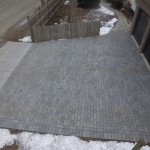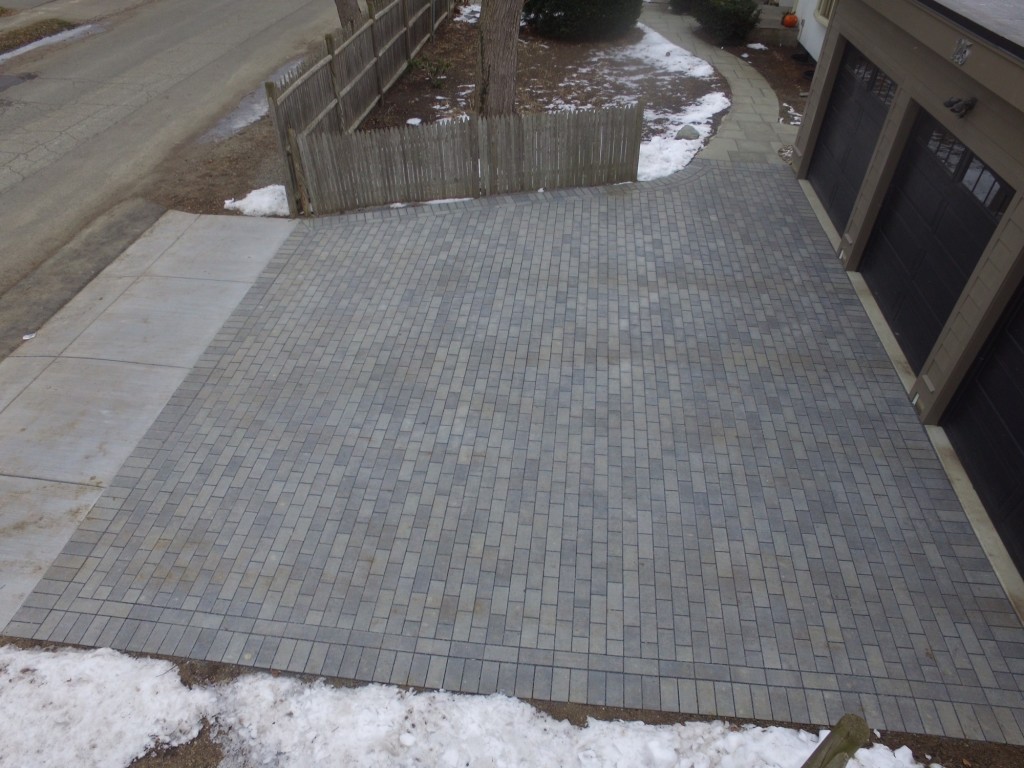
By Anne-Marie Lambert
Most Belmont driveways are impervious surfaces, and they make local flooding and water pollution worse—but that doesn’t have to be the case. When a driveway is made of asphalt or concrete, rainfall flows quickly to catch basins, erodes soil along the way, and increases pollution and flooding risks in downstream neighborhoods. Water that soaks into the soil doesn’t have any of these effects. More and more homeowners are taking advantage of today’s porous paver technologies in order to allow the soil to soak up rain before it reaches our catch basins and waterways. Plus, the pavers can look great.
In the article “Homeowners Can Reduce Yard Runoff,” (BCF Newsletter, September/ October 2014), Anne and Fred Paulsen described their plans for replacing their cracked concrete driveway on School Street with porous pavers and turf pavers. As part of their project, the Paulsens also added a drainage grate in front of their barn. The grate directs stormwater flowing off the roof over to the lawn on the side of the barn. The Paulsens also installed a dry well at the back of their house to collect runoff from the drainpipes connected to the gutters on the roof.
In the downstream Winn Brook neighborhood, Allison Lenk and Sebastian Kossak were inspired by BCF Newsletter articles to research options for resurfacing the 30-foot gravel driveway to their three-car garage. Like the Paulsens, they made a decision this fall to install pavers placed far enough apart that water can drip down between them into an underground containment area. They chose Premier Pavers and Hardscape Co. of Lincoln, Mass., to do the work.
At this Winn Brook site, 16 inches of underground drainage space was excavated and filled with 13 inches of permeable stone base under 3-inch pavers because the clay soil was not porous; without the permeable base, water would have pooled and run off the site. The project took about five days to install and was completed in December. It cost about twice as much as an asphalt surface. Guidelines from the Interlocking Concrete Pavement Institute (www.icpi.org) were followed to ensure minimal maintenance requirements. Lenk recommends getting several different estimates from companies with experience installing pervious pavers, and seeking out testimonials and recommendations from prior customers. She reports, “Seb and I are so glad that the driveway is completed—it looks great!”
For a historical perspective on impervious driveways, consider that the first tar road in Belmont was Pleasant Street, proudly laid with a steamroller in 1907. According to Richard Betts’s book, The Streets of Belmont and How they were Named, over the next 100 years, the total number of miles represented by the streets of Belmont more than doubled, from under 40 miles to more than 80 miles. Each mile of street now includes dozens of driveways. As the automobile gained in popularity, farms and meadows were replaced by today’s suburban housing developments, and asphalt driveways became standard.
The historic approach to stormwater runoff became “pave it, pipe it, and pump it away.” Today we know a lot more about the unintended consequences of this approach. Slowly but surely, paving driveways has:
Killed the biological life in the soil beneath our driveways
Increased hydrocarbons and other car-related pollution in our waterways
Eroded nearby soil as runoff rushes from paved surfaces to catch basins
Increased sediment in waterways
In this way, paved driveways have contributed to rivers, streams, and ponds becoming shallower from the bottom up, resulting in increased temperatures in waterways, affecting fish and other species, and reduced capacity to absorb heavy rainfalls in rivers, streams, and ponds
With storms becoming more frequent and more intense, it is becoming increasingly important to take action to mitigate the effects of the last 100 years of paving. Winter is a great time for homeowners to do the research necessary to understand what it would take to make your particular driveway both permeable and attractive.
For more information about Belmont stormwater, see belmontcitizensforum.org/stormwater, or email to bcfprogramdirector@gmail.com ro contact the Belmont Stormwater Working Group, a group of citizens concerned about our stormwater issues.
Anne-Marie Lambert is a Director of the Belmont Citizens Forum.



Sorry, the comment form is closed at this time.